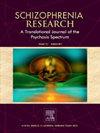Childhood sexual abuse in first-episode psychosis: The relevance in cognitive bias
IF 3.5
2区 医学
Q1 PSYCHIATRY
引用次数: 0
Abstract
Cognitive biases and childhood trauma have been associated with psychotic outcomes; however, the combined effect of these two variables on psychosis has been minimally explored. This study investigates differences in cognitive biases and the presence of sexual abuse between people with first episode of psychosis (FEP) and healthy controls and explores the relationship between childhood sexual abuse and cognitive biases in individuals with FEP, controlling for sociodemographic and clinical confounders. A sample of 85 FEP patients and 87 healthy controls were assessed using the Spanish version of the Cognitive Biases Questionnaire for Psychosis (CBQp) and the Childhood Trauma Questionnaire (CTQ). Participants with FEP exhibited higher levels of cognitive biases (p = .006), including in threatening situations, (p = .022), anomalous perceptions (p = .005), intentionality (p = .007), jumping to conclusions (p = .009), and emotional reasoning (p = .001), compared to healthy controls, while no significant differences were found in catastrophism and dichotomous thinking. FEP participants also reported a higher incidence of childhood sexual abuse (p = .024). Regressions models using enter method indicated that childhood sexual abuse was associated with dichotomous thinking, a pattern of “all-or-nothing” thinking, and emotional reasoning biases, even after adjusting for age, education, psychotic symptoms, and perceived stress. These results highlight the importance of addressing trauma history in early psychosis interventions, emphasizing cognitive-behavioral strategies like Metacognitive Training and Eye Movement Desensitization and Reprocessing.
首发精神病的儿童期性虐待:认知偏差的相关性
认知偏差和童年创伤与精神病预后有关;然而,这两个变量对精神病的综合影响已经很少被探索。本研究探讨首发精神病(FEP)患者与健康对照者在认知偏差和性虐待存在方面的差异,并在控制社会人口统计学和临床混杂因素的情况下,探讨儿童期性虐待与首发精神病患者认知偏差之间的关系。采用西班牙语版精神病认知偏差问卷(CBQp)和儿童创伤问卷(CTQ)对85例FEP患者和87名健康对照进行评估。与健康对照组相比,患有FEP的参与者表现出更高水平的认知偏差(p = 0.006),包括在威胁情境(p = 0.022)、异常感知(p = 0.005)、意向性(p = 0.007)、草率结论(p = 0.009)和情绪推理(p = 0.001),而在灾难论和二元思维方面没有发现显著差异。FEP参与者也报告了较高的儿童期性虐待发生率(p = 0.024)。使用进入法的回归模型表明,即使在调整了年龄、教育、精神病症状和感知压力之后,儿童性虐待与二分思维、“全有或全无”思维模式和情感推理偏差有关。这些结果强调了在早期精神病干预中处理创伤史的重要性,强调了认知行为策略,如元认知训练和眼动脱敏和再加工。
本文章由计算机程序翻译,如有差异,请以英文原文为准。
求助全文
约1分钟内获得全文
求助全文
来源期刊

Schizophrenia Research
医学-精神病学
CiteScore
7.50
自引率
8.90%
发文量
429
审稿时长
10.2 weeks
期刊介绍:
As official journal of the Schizophrenia International Research Society (SIRS) Schizophrenia Research is THE journal of choice for international researchers and clinicians to share their work with the global schizophrenia research community. More than 6000 institutes have online or print (or both) access to this journal - the largest specialist journal in the field, with the largest readership!
Schizophrenia Research''s time to first decision is as fast as 6 weeks and its publishing speed is as fast as 4 weeks until online publication (corrected proof/Article in Press) after acceptance and 14 weeks from acceptance until publication in a printed issue.
The journal publishes novel papers that really contribute to understanding the biology and treatment of schizophrenic disorders; Schizophrenia Research brings together biological, clinical and psychological research in order to stimulate the synthesis of findings from all disciplines involved in improving patient outcomes in schizophrenia.
 求助内容:
求助内容: 应助结果提醒方式:
应助结果提醒方式:


